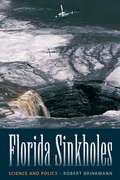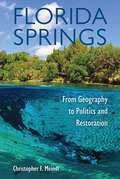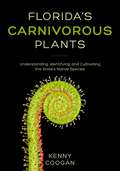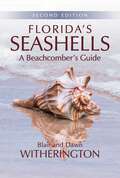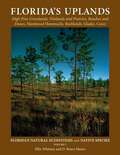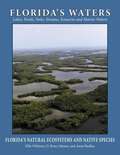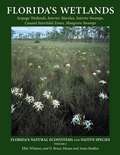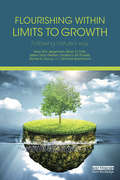- Table View
- List View
Florida Sinkholes: Science and Policy
by Robert BrinkmannBelow the live oaks, palm trees, cypress swamps, and springs, water is slowly wearing away the limestone bedrock of Florida. The erosion is often unseen, and over time it can result in shocking cave-ins like the destructive spectacle of the 1981 Winter Park sinkhole.Florida Sinkholes--the first comprehensive book on the subject--is an easy-to-follow guide to understanding how sinkholes form and what to do about Florida's sometimes pockmarked landscape. City planners, construction managers, developers, and homeowners alike will find this book invaluable because of the heavy impact and increasing frequency of sinkhole formation in the state. Amateur geologists will be fascinated by the subtle forces of nature that can make solid rock disappear. Tackling the problem of sinkholes in useful detail, this book packs an abundance of sound scientific fact into frank, readable language. Learn about the captivating workings of karst, a term for the swiss cheese-like formations of soluble rock that underlie the peninsula. Discover current state-of-the-art approaches to mapping sinkholes and subsurface voids. Review such practical concerns as structural damage, repairs, insurance problems, and management of karst lands. Examine case studies of several notable sinkholes and sinkhole events. Even before you've finished reading, you may find yourself itching to get out and visit these intriguing marvels of Florida geology for yourself.
Florida Springs: From Geography to Politics and Restoration
by Christopher F. MeindlThis book provides a clear and comprehensive overview of the geography, history, science, and politics of Florida’s freshwater springs, informing readers about the deep past and current issues facing these natural wonders of the state.
Florida's Birds: A Field Guide and Reference
by David S. Maehr Herbert W. KaleThis illustrated guide to Florida's birds includes full-color illustrations and detailed descriptions of each species, and covers such topics as exotic and endangered species; bird conservation and study; finding, attracting, and feeding birds, bird problems, and the care of sick and injured birds.
Florida's Carnivorous Plants: Understanding, Identifying, and Cultivating the State's Native Species
by Kenny CooganLearn about Florida's endemic carnivorous plants in this exciting book written for the budding naturalist and hobbyist. Florida has dozens of native species of carnivorous plants––more than any other state in the United States—including sundews, butterworts, bladderworts, and pitcher plants. These plants use appealing scents, leaves, and sticky fluids to trap and imprison insects. Digestive fluids then absorb the prey giving the plant its nutrients. Many of these plants can be grown at home in the backyard, in rain gardens, or in some cases on the windowsill. Florida&’s Carnivorous Plants provides an identification and growing guide for the major genera of carnivorous plants found in Florida. Each species description includes etymology, a history of the plant&’s discovery highlighting diverse scientists, anatomy, habitat range, and popular cultivars for beginners. Tables include soil requirements, types of potting, water level, amount of light, dormancy and temperature requirements, and propagation tips. A glossary provides readers with the tools to learn botanical jargon to improve their identification skills.
Florida's Coast-to-Coast Trail Guide: 250-Miles of C2C Bicycle Rides and Walks- Titusville to St. Petersburg
by Nanci AdlerFlorida's Coast-to-Coast Trail Guide is a guidebook designed specifically for the 250-mile dedicated bicycle/pedestrian trail that provides an uninterrupted cross-Florida trail from Titusville to St. Petersburg. The trail (over 80% complete and to be completed by 2025) already attracts not only local cyclists and walkers, but also out-of-state cycling enthusiasts. This book provides readers with a broad background of the communities through which they will travel. Although maps are included, this is not a detailed "how-to" guide, nor does it provide extensive lodging, camping or restaurant information; much of that information changes frequently and can be easily obtained via online searches. Instead, this book focuses on interesting cultural and natural aspects of the route. By highlighting the local flavor of small towns, the beauty of natural Florida, as well as local historical events, this book will introduce readers to the uniqueness of Florida. Distinctive features covered in the book include the Greek heritage of Tarpon Springs, Winter Garden's thriving downtown based on its citrus and bass-fishing past, Titusville's role in space exploration, and St. Petersburg&’s lively waterfront and flourishing art scene. Also covered is the natural world of beautiful freshwater springs, moss-shrouded oak trees, and migratory birds found in protected areas along the trail such as Gemini Springs Park, Brooker Creek Preserve and the Green Swamp. In addition, readers will be introduced to important historical Florida figures such as civil rights leaders Harry T. and Harriett V. Moore and Russian entrepreneur and railway builder Peter Demens.
Florida's Incredible Wild Edibles
by Florida Native Plant SocietyFrom Sassafras to Dandelions to Wild Onions and Garlic, readers will enjoy the flavors of the Sunshine State in an all new way with this helpful book. Florida is filled with an abundance of native plants with roots, stems, leaves, flowers, fruit, and seeds that can provide tasty and nutritious food for people. Salads, teas, soups, and even breads can be made from flora that grows wild and can be foraged throughout the year. This guide offers identification tips, recipes, and other useful information for foragers interested in venturing out to sample the bounty of the land. Clear pen-and-ink illustrations aid in identification of leaf, fruit, and root shapes—key to harvesting the delicious and interesting plants that can be found throughout the state.
Florida's Rivers: A Celebration of Over 40 of the Sunshine State's Dynamic Waterways
by Doug AldersonThe rivers in Florida are steeped in a rich natural and cultural history. They are avenuesthrough time, allowing us to wrap ourselves in a rich historical tapestry, and they are showcases for wildlife and natural beauty. On some rivers, idyllic scenes are revealed bend after bend for miles and sometimes days, appearing to have changed little since early native people plied the waters in dugout canoes.Imagine gliding along a clear watercourse beneath a leafy canopy of maple, cypress, and gum. The current swirls eelgrass in undulating patterns as schools of silvery mullet shoot past. Ahead, a manatee&’s snout breaks the surface in a loud whoosh, its gray body lumbering slowly along and showing little fear as you pass by. A red-shouldered hawk cries and soars over treetops while a black anhinga stretches long wings to dry while perched on a cypress knee.Whether you are viewing a river from the land or, especially, a kayak, canoe, or paddleboard, let Florida's Rivers be your guide to celebrating the state's treasures.
Florida's Seashells: A Beachcomber's Guide
by Blair WitheringtonFlorida's Seashells, the bestselling guide for beachcombers, is now updated and expanded in a new edition. This new volume has more shells identified and explained, with 287 species represented by over 400 full-color images and 175 range maps.This book showcases the diversity of Florida's seashells and presents them in the way they come to us on beaches. Knowing the names, stories, and varied appearances of seashells can sharpen a beachcomber's eyes to their beauty and rarity, and offer collectors an outlet for the appreciation of nature's splendor. The book's elegant organization allows easy identification of seashells common to the southeastern United States and the Caribbean.Other Pineapple Press guides for the curious beachcomber:Florida's Living BeachesSeashells of Georgia and the CarolinasLiving Beaches of Georgia and the Carolinas
Florida's Uplands (Florida's Natural Ecosystems and Native Species)
by Ellie Whitney Anne Rudloe D Bruce MeansTaken from the earlier book Priceless Florida (and modified for a stand-alone book), this volume discusses the well-drained areas of Florida, including high pine grasslands, flatwoods and prairies, interior scrub, hardwood hammocks, rocklands and caves, and beach dunes. Introduces readers to the trees and plants, insects, mammals, reptiles, and other species that live in Florida's unique uplands ecosystem.Next in series > >See all of the books in this series
Florida's Waters (Florida's Natural Ecosystems and Native Species)
by Ellie Whitney Anne Rudloe D Bruce MeansTaken from the earlier book Priceless Florida (and modified for a stand-alone book), this volume discusses the fresh- and saltwater systems of Florida, including lakes and ponds; rivers and streams; springs; aquatic caves; estuarine waters and seafloors; submarine meadows, sponge, rock, and reef communities; and the Gulf and Atlantic Ocean. Introduces readers to the trees and plants, insects, mammals, reptiles, and other species that live in Florida's unique water ecosystems, including chicken turtle, barking treefrogs, osprey, herons, bass, crayfish, conchs, cordgrass, and railroad vine. Discusses the food chain and the interconnectedness of all species.See all of the books in this series
Florida's Wetlands (Florida's Natural Ecosystems and Native Species)
by Ellie Whitney Anne Rudloe D Bruce MeansTaken from the earlier book Priceless Florida (and modified for a stand-alone book), this volume discusses Florida's wetlands, including interior wetlands, seepage wetlands, marshes, flowing-water swamps, beaches and marine marshes, and mangrove swamps. Introduces readers to the trees and plants, insects, mammals, reptiles, and other species that live in Florida's unique wetlands ecosystem, including the Virginia iris, American white waterlily, cypress, treefrogs, warblers, and the Florida black bear.Next in series > >See all of the books in this series
Floriography: The Myths, Magic & Language of Flowers
by Sally CoulthardFlowers can talk. Red roses say ‘I love you’, white lilies offer condolence and poppies invite us to remember.For thousands of years, humans have used flowers as a language, a short-hand for emotions and meanings. In her new book, Sally Coulthard, takes a fascinating look at floriography and shows how we still use this secret language across the world. She delves into the meanings of flowers and where they came from, whether it’s ancient mythology or hedgerow folklore.Covering 50 well-loved flowers and plants, from peonies to sweetpeas, ivy to irises, Floriography is a beautifully illustrated guide that will take the reader on an intriguing journey through the history, legend, anthropology and literature of flowers, showing how modern-day society still relies on the meaning of flowers. From the Chinese lotus flower to the Celtic bluebell, the myth, magic and language of flowers is still blossoming today.
Flourish
by Willow CrossleyInspired by wild and wayward floral styles, Willow Crossley creates natural and original arrangements, from cabbage rose to cow-parsley, the book will range from glorious garlands and pretty posies to stunning centrepieces for a banquet or soiree. Flourish demonstrates how easy it is to transform a handful of fresh cuttings into arrangements to decorate your home throughout the year. Arranged by season, Spring covers foxgloves, cowslips and snake head fritillaries, while Summer offers bouquets of roses to rosemary and Autumn includes arrangements of crab apples, chocolate cosmos and clematis flowers. For Winter, Willow draws from ivy, moss and snowberries, whilst also demonstrating how to make an Old Man's Beard- a giant wreath of beautiful white and snow-coloured flowers. This is an original and stylish guide to decorating your home with interesting seasonal blooms and foliage; be it a relaxed lunch table or an elaborate dinner soiree, there is something for every taste and occasion.
Flourish by Design
by Leon Cruickshank Nick Dunn Gemma CoupeFlourish by Design brings together a range of established and emerging voices in design research for a collection that provides original provocations on topics of global significance. It is an insightful guide to original theory and practice concerning how we can design for a better tomorrow. Featuring contributors from a diverse array of backgrounds and professions, this edited book explores the difference that design and design research can make for people, organisations, and the planet to prosper now and in the future. It offers a range of ideas and techniques through practical examples and ongoing projects showing how applied design research can respond to global challenges. Covering topics as diverse as artificial intelligence, bio-inspired materials, more-than-human design, sustainability, and urban acupuncture, it shares interdisciplinary and transdisciplinary design research not just to demonstrate what could be plausible in the near future but also to explain why it might be preferable. By sharing these despatches, this collection represents the very best of what design research can do, explaining how and why. This book is intended for a wide audience of professionals, scholars, and students in design, architecture, and public policy, as well as anyone who has an interest in how we design the world and, in turn, it designs us. The Open Access version of this book, available at www.taylorfrancis.com, has been made available under a Creative Commons Attribution-Non Commercial-No Derivatives (CC-BY-NC-ND) 4.0 license
Flourish: Stunning Arrangements With Flowers And Foliage For Every Season
by Willow CrossleyInspired by wild and wayward floral styles, Willow Crossley creates natural and original arrangements, from cabbage rose to cow-parsley, the book will range from glorious garlands and pretty posies to stunning centrepieces for a banquet or soiree. Flourish demonstrates how easy it is to transform a handful of fresh cuttings into arrangements to decorate your home throughout the year. Arranged by season, Spring covers foxgloves, cowslips and snake head fritillaries, while Summer offers bouquets of roses to rosemary and Autumn includes arrangements of crab apples, chocolate cosmos and clematis flowers. For Winter, Willow draws from ivy, moss and snowberries, whilst also demonstrating how to make an Old Man's Beard- a giant wreath of beautiful white and snow-coloured flowers. This is an original and stylish guide to decorating your home with interesting seasonal blooms and foliage; be it a relaxed lunch table or an elaborate dinner soiree, there is something for every taste and occasion.
Flourishing Within Limits to Growth: Following nature's way
by Sven Erik Jørgensen Brian D. Fath Søren Nors Nielsen Federico M. Pulselli Daniel A. Fiscus Simone BastianoniDecades of research and discussion have shown that the human population growth and our increased consumption of natural resources cannot continue – there are limits to growth. This volume demonstrates how we might modify and revise our economic systems using nature as a model. The book describes how nature uses three growth forms: biomass, information, and networks, resulting in improved overall ecosystem functioning and co-development. As biomass growth is limited by available resources, nature uses the two other growth forms to achieve higher resource use efficiency. Through a universal application of the three ‘R’s: reduce, reuse, and recycle, nature thus shows us a way forward towards better solutions. However, our current approach, dominated by short-term economic thinking, inhibits full utilization of the three ‘R’s and other successful approaches from nature. Building on ecological principles, the authors present a global model and futures scenario analyses which show that implementation of the proposed changes will lead to a win-win situation. In other words, we can learn from nature how to develop a society that can flourish within the limits to growth with better conditions for prosperity and well-being.
Flourishing in the Age of Climate Change
by William M. ThroopFlourishing in the Age of Climate Change explores skills we need to successfully navigate the distinctive environmental, social, and economic challenges of the twenty-first century. Our inability to address increasing resource constraints, social conflict, and ecological decline lead many toward a deep pessimism that saps motivation for change. Drawing on research from environmental science, ethics, psychology, sociology and educational theory, William M. Throop shows why cultivating underdeveloped skills involved in collaboration, humility, frugality and systems thinking can enable flourishing within our context. He also illustrates how we can strengthen such skills individually and how education can scale up their cultivation, which will be essential for achieving sustainability. Flourishing in the Age of Climate Change is a hopeful, practical resource for readers passionate about creating a world where we can thrive, and where flourishing is widespread.
Flow: The Life and Times of Philadelphia's Schuylkill River
by Beth KephartThe Schuylkill River-the name in Dutch means "hidden creek"-courses many miles, turning through Philadelphia before it yields to the Delaware. "I am this wide. I am this deep. A tad voluptuous, but only in places," writes Beth Kephart, capturing the voice of this natural resource in Flow. An award-winning author, Kephart's elegant, impressionistic story of the Schuylkill navigates the beating heart of this magnificent water source. Readers are invited to flow through time-from the colonial era and Ben Franklin's death through episodes of Yellow Fever and the Winter of 1872, when the river froze over-to the present day. Readers will feel the silt of the Schuylkill's banks, swim with its perch and catfish, and cruise-or scull-downstream, from Reading to Valley Forge to the Water Works outside center city. Flow's lush narrative is peppered with lovely, black and white photographs and illustrations depicting the river's history, its people, and its gorgeous vistas. Written with wisdom and with awe for one of the oldest friends of all Philadelphians, Flow is a perfect book for reading while the ice melts, and for slipping in your bag for your own visit to the Schuylkill.
Flower
by Andrew ZuckermanIn this collection, Andrew Zuckerman, beloved photographer of Creature and Bird, moves from fauna to flora, turning his lens onto the most beautiful specimens of the plant kingdom. Spectacular close-up images of 150 flower species, both exotic and familiar, are lovingly captured in Zuckerman's bold yet sensitive signature style. Showcased against pure white backgrounds, the complexity of color and structure in each specimen is revealed--creating flower portraits of astonishing radiance and detail. Zuckerman's award-winning minimalism serves as the perfect foil for these lush natural wonders. A rich visual tour of nature's most beloved beauties, this substantial tome is a timeless treasure for flower lovers, garden enthusiasts, photography buffs, and collectors of Zuckerman's work.
Flower Arranging for Beginners: Learn How to Create Stunning Arrangements
by Amy BareneYour ultimate guide to building beautiful bouquetsFlowers are a gorgeous gift from nature! They can boost your mood or brighten a room—and custom flower arrangements are an amazing way to express yourself as you bring the beauty of the outdoors in. With this beginner's guide to flower arranging, you'll discover the secrets to matching colors and styles and creating a cohesive aesthetic that transforms your favorite flowers into stunning centerpieces. Gather your materials —Discover what it takes to assemble a healthy bouquet, from assessing and preparing flowers to the right tools, and choosing a vase or vessel. Explore floral design —Learn about the artistic elements that help create eye-catching arrangements, like color scheme, texture, harmony, and scale. Get ready to arrange —Experiment with 25 classic and contemporary arrangements that feature vivid illustrations and simple, step-by-step instructions to ensure success. Liven up your space with this beginner-friendly flowering arranging book .
Flower Colors (Fountas & Pinnell LLI Blue #Level B)
by Josephine SelwynPart of the Learn-Abouts guided reading program, this beginning reader introduces a nonfiction topic, with the use of a picture dictionary.
Flower Confidential
by Amy StewartWe buy more flowers a year than we do Big Macs, spending $6. 2 billion annually. We use them to mark our most important events, to express sentiments that might otherwise go unsaid. And we demand perfection. So it's no surprise that there is a $40 billion global industry devoted to making flowers flawless. Amy Stewart takes us inside the flower trade-from the hybridizers, who create new varieties in the laboratory, to the growers, who produce flowers by the millions (often in a factory-like setting), to the Dutch auctioneers, who set the bar (and the price), and ultimately to the neighborhood florists orchestrating the mind-boggling demands of Valentine's and Mother's Day. There's the breeder intent on developing the first blue rose; an eccentric horticultural legend who created the world's most popular lily; a grower of gerberas of every color imaginable; and the equivalent of a Tiffany diamond: the " Forever Young" rose. Stewart explores the relevance of flowers in our lives and in our history, and in the process she reveals all that has been gained-and lost-by tinkering with nature.
Flower Confidential: The Good, the Bad, and the Beautiful
by Amy StewartAward-winning author Amy Stewart takes readers on an around-the-world, behind-the-scenes look at the flower industry and how it has sought—for better or worse—to achieve perfection. She tracks down the hybridizers, geneticists, farmers, and florists working to invent, manufacture, and sell flowers that are bigger, brighter, and sturdier than anything nature can provide. <P><P>There's a scientist intent on developing the first genetically modified blue rose; an eccentric horitcultural legend who created the most popular lily; a breeder of gerberas of every color imaginable; and an Ecuadorean farmer growing exquisite roses, the floral equivalent of a Tiffany diamond. And, at every turn she discovers the startling intersection of nature and technology, of sentiment and commerce.
Flower Day: A Story of 24 Hours and 24 Floral Lives (Earth Day)
by Sandra KnappAn illustrated hourly guide that spotlights twenty-four flowers as they attract pollinators, resist predators, and survive on our changing planet. Is it 4 AM or chicory o’clock? In this short book, botanist and award-winning author Sandra Knapp walks us through a day in a global garden. Each chapter of Flower Day introduces a single flower during a single hour, highlighting twenty-four different species from around the world. Beginning at midnight in the Americas, we spot the long tubular flowers of the moonflower, Ipomoea alba; they attract a frenzy of hawk moths before the dawn arrives and the flowers wither and collapse. As day breaks, dandelions and chicory open their heads—actually made up of many individual flowers tightly packed together—and flies and bees visit to get the energy they need to lay eggs and raise their young. Later, at eight o’clock in the morning, the sun rises over the watery Amazon basin, and we meet the giant waterlily, slowly turning from white to pink and purple. Trapped inside are the beetles who feasted on the flowers during the night. That evening, at seven o’clock, we travel to the Caribbean to smell night-blooming jessamine’s powerful—some may say nauseating—sweet scent. But this member of the nightshade family isn’t just a thing of beauty—it has a reputation as both a poison and invasive species, crowding out endangered native trees. For each hour in our flower day, celebrated artist Katie Scott has depicted these scenes with gorgeous pen-and-ink illustrations. Working closely together to narrate and illustrate these unique moments in time, Knapp and Scott have created an engaging read that is a perfect way to spend an hour or two—and a true gift for amateur botanists, gardeners, and anyone who wants to stop and appreciate the flowers.
Flower Development
by José Luis Riechmann Frank WellmerIn Flower Development: Methods and Protocols, researchers in the field detail protocols for experimental approaches that are currently used to study the formation of flowers, from genetic methods and phenotypic analyses, to genome-wide experiments, modeling, and system-wide approaches. Written in the highly successful Methods in Molecular Biology series format, chapters include introductions to their respective topics, lists of the necessary materials and reagents, step-by-step, readily reproducible laboratory protocols, and key tips on troubleshooting and avoiding known pitfalls Authoritative and practical, Flower Development: Methods and Protocols is an essential guide for plant developmental biologists, from thenovice to the experienced researcher, and for those considering venturing into the field. "
